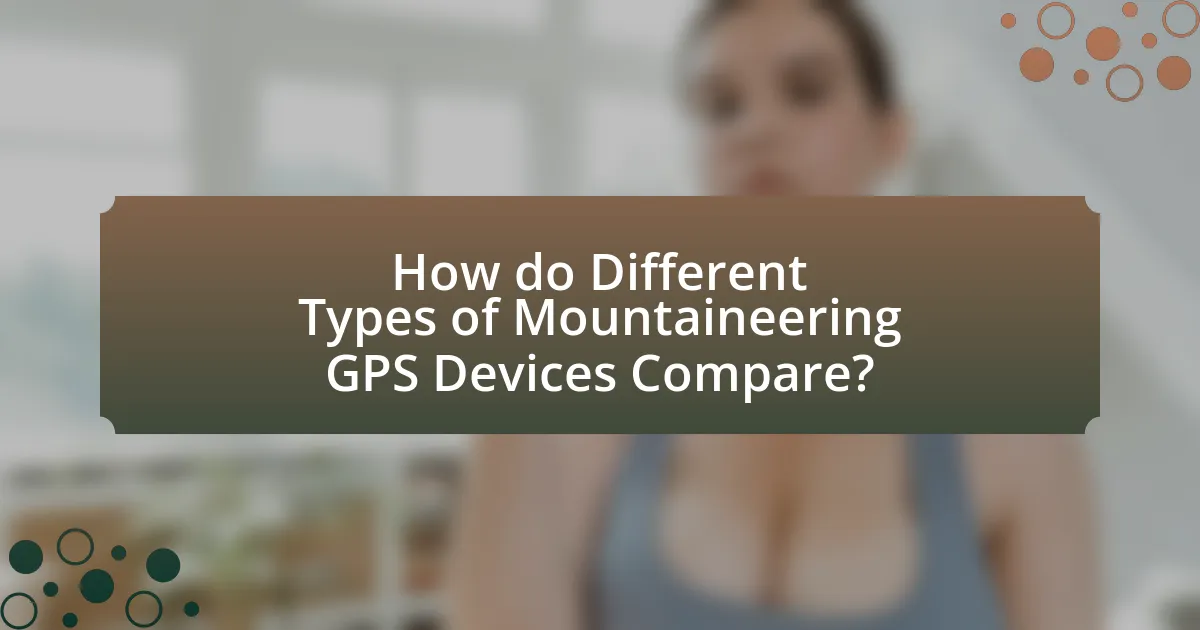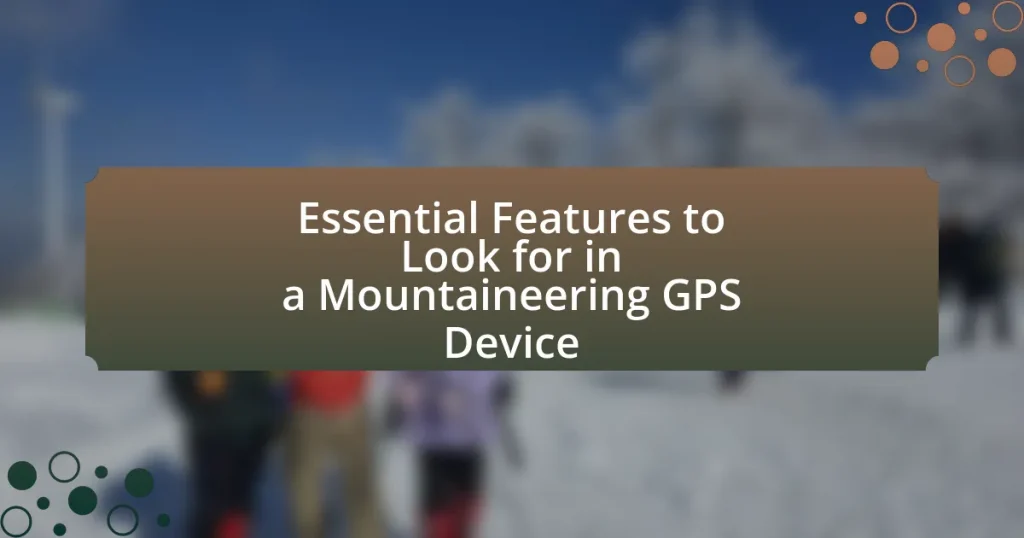The article focuses on the essential features to consider when selecting a mountaineering GPS device, emphasizing the importance of accurate positioning, rugged design, long battery life, topographic mapping, and waypoint navigation. It highlights how these features enhance the mountaineering experience by improving navigation, safety, and decision-making. Additionally, the article discusses the significance of functionalities such as weather forecasting, route planning, and the advantages of built-in altimeters and barometers. It also compares different types of GPS devices, including handheld and wrist-mounted options, and provides guidance on factors to consider when purchasing, such as brand reputation, user reviews, and warranty options.

What are the Essential Features of a Mountaineering GPS Device?
The essential features of a mountaineering GPS device include accurate positioning, rugged design, long battery life, topographic mapping, and waypoint navigation. Accurate positioning is crucial for safety and navigation in remote areas, often achieved through GPS and GLONASS satellite systems, which enhance location accuracy. A rugged design ensures durability against harsh weather conditions and impacts, making the device reliable in challenging environments. Long battery life is vital for extended trips, with many devices offering 20 hours or more on a single charge. Topographic mapping provides detailed terrain information, allowing users to understand elevation changes and plan routes effectively. Waypoint navigation enables users to mark and return to specific locations, enhancing route planning and safety during mountaineering activities.
How do these features enhance the mountaineering experience?
The essential features of a mountaineering GPS device enhance the mountaineering experience by providing accurate navigation, real-time tracking, and safety alerts. Accurate navigation ensures that climbers can follow the correct routes, reducing the risk of getting lost in challenging terrains. Real-time tracking allows climbers to monitor their progress and adjust their plans based on current conditions, which is crucial for time management and safety. Safety alerts, such as weather warnings and emergency signals, help mountaineers respond promptly to changing conditions, thereby increasing their chances of a safe return. These features collectively improve decision-making and overall confidence during mountaineering expeditions.
What role does accuracy play in navigation with a GPS device?
Accuracy is crucial in navigation with a GPS device as it determines the precision of location data provided to the user. High accuracy ensures that users can pinpoint their exact location, which is essential for safe and effective navigation, especially in challenging environments like mountains. For instance, modern GPS devices can achieve accuracy within 5 to 10 meters under optimal conditions, significantly enhancing the user’s ability to navigate complex terrains and avoid hazards. This level of precision is supported by advancements in satellite technology and signal processing, which collectively improve the reliability of GPS data in real-time navigation scenarios.
How does battery life impact the usability of a GPS device in the mountains?
Battery life significantly impacts the usability of a GPS device in the mountains by determining how long the device can operate without needing a recharge. In remote mountainous areas, access to power sources is limited, making extended battery life crucial for navigation and safety. For instance, a GPS device with a battery life of 20 hours can support multi-day hikes, while one with only 5 hours may fail during critical navigation moments. Therefore, a longer battery life enhances reliability and usability, ensuring that users can maintain their route and access essential features like tracking and waypoint navigation throughout their journey.
What specific functionalities should a mountaineering GPS device have?
A mountaineering GPS device should have functionalities such as accurate positioning, topographic mapping, route planning, and weather forecasting. Accurate positioning is essential for navigation in remote areas, typically achieved through GPS satellites, which provide location data within a few meters. Topographic mapping allows users to view terrain features, helping in route selection and hazard identification. Route planning enables users to create and save custom paths, facilitating efficient navigation. Weather forecasting features provide real-time updates on conditions, which is crucial for safety in changing mountain environments. These functionalities collectively enhance the reliability and usability of the device for mountaineering activities.
How important is topographic mapping for mountaineers?
Topographic mapping is crucial for mountaineers as it provides detailed information about terrain features, elevation changes, and potential hazards. This mapping allows mountaineers to plan their routes effectively, assess the difficulty of climbs, and navigate safely through challenging landscapes. Studies show that accurate topographic maps can significantly reduce the risk of accidents by helping climbers identify safe paths and avoid dangerous areas, such as steep cliffs or unstable ground.
What are the advantages of having a built-in altimeter and barometer?
Having a built-in altimeter and barometer in a mountaineering GPS device provides critical advantages for outdoor navigation and safety. The altimeter accurately measures elevation changes, allowing users to track their ascent or descent, which is essential for route planning and ensuring they remain on course in mountainous terrain. The barometer, on the other hand, monitors atmospheric pressure, enabling users to predict weather changes, such as incoming storms or shifts in conditions, which is vital for safety during outdoor activities. Together, these features enhance situational awareness and decision-making, significantly improving the overall mountaineering experience.
What additional features can improve safety and efficiency?
Additional features that can improve safety and efficiency in a mountaineering GPS device include real-time weather updates, emergency SOS functionality, and topographic mapping. Real-time weather updates provide critical information about changing conditions, which can prevent dangerous situations. Emergency SOS functionality allows users to send distress signals with their location, significantly increasing the chances of rescue in emergencies. Topographic mapping enhances navigation by providing detailed terrain information, helping users make informed decisions about their routes. These features collectively enhance the overall safety and efficiency of mountaineering activities.
How does route planning functionality benefit mountaineers?
Route planning functionality significantly benefits mountaineers by enabling them to create and follow optimized paths tailored to their specific needs and conditions. This feature allows mountaineers to assess terrain, elevation changes, and potential hazards, ensuring safer and more efficient navigation. For instance, studies show that effective route planning can reduce the risk of accidents by up to 30% by helping climbers avoid dangerous areas and choose safer alternatives. Additionally, accurate route planning can enhance time management, allowing mountaineers to allocate their resources effectively and reach their destinations within planned timeframes.
What is the significance of weather forecasting capabilities in a GPS device?
Weather forecasting capabilities in a GPS device are significant because they provide real-time meteorological data that can enhance safety and decision-making for outdoor activities. These capabilities allow users to anticipate weather changes, which is crucial in mountaineering where conditions can shift rapidly. For instance, a study by the National Oceanic and Atmospheric Administration (NOAA) indicates that timely weather information can reduce the risk of accidents by enabling climbers to avoid severe weather events, such as storms or extreme temperature drops. Thus, integrating weather forecasting into GPS devices directly contributes to improved safety and planning for mountaineers.

How do Different Types of Mountaineering GPS Devices Compare?
Different types of mountaineering GPS devices vary primarily in functionality, accuracy, and user interface. Handheld GPS devices typically offer robust features such as topographic maps, waypoint marking, and long battery life, making them suitable for serious mountaineers. In contrast, wrist-mounted GPS devices provide convenience and ease of access, often integrating fitness tracking features, but may lack the detailed mapping capabilities of handheld units. Smartphone GPS apps can be useful for casual hikers due to their accessibility and additional features like social sharing, but they depend on battery life and signal availability, which can be limiting in remote areas. Research indicates that handheld devices generally provide superior accuracy and reliability in challenging terrains, with many models featuring advanced satellite connectivity options, such as GLONASS and Galileo, enhancing their performance in mountainous environments.
What are the differences between handheld and wrist-mounted GPS devices?
Handheld GPS devices are typically larger, offer more features, and have greater battery life compared to wrist-mounted GPS devices, which are more compact and designed for convenience. Handheld devices often include advanced mapping capabilities, larger screens for easier navigation, and additional functionalities such as topographic maps and waypoint management, making them suitable for extensive outdoor activities. In contrast, wrist-mounted GPS devices prioritize portability and ease of access, allowing users to track their location and fitness metrics on the go, but they usually have limited screen size and fewer features. The differences in size, functionality, and intended use highlight the specific advantages of each type for various outdoor activities.
What are the pros and cons of using a smartphone as a GPS device?
Using a smartphone as a GPS device has both advantages and disadvantages. The pros include accessibility, as smartphones are widely available and often come with built-in GPS capabilities, making them convenient for navigation without additional costs. Additionally, smartphones offer real-time updates and a variety of apps that enhance navigation, such as offline maps and route planning features. On the other hand, the cons involve battery life, as GPS usage can drain a smartphone’s battery quickly, potentially leaving users without navigation in remote areas. Furthermore, smartphones may lack the ruggedness and durability of dedicated GPS devices, making them less suitable for harsh mountaineering conditions.
How do brand and model affect the features of GPS devices?
Brand and model significantly influence the features of GPS devices by determining the technology, user interface, and additional functionalities offered. Different brands, such as Garmin and TomTom, often prioritize distinct features; for instance, Garmin devices typically include advanced navigation capabilities and robust mapping options, while TomTom may focus on user-friendly interfaces and real-time traffic updates. Additionally, specific models within a brand can vary in features, such as screen size, battery life, and waterproof ratings, which are crucial for mountaineering. For example, Garmin’s GPSMAP series offers rugged designs and extensive topographic maps, catering specifically to outdoor enthusiasts, while entry-level models may lack these specialized features. Thus, the choice of brand and model directly impacts the overall performance and suitability of GPS devices for specific activities like mountaineering.
What should you consider when choosing a brand for mountaineering GPS devices?
When choosing a brand for mountaineering GPS devices, consider the brand’s reputation for durability and accuracy. Brands like Garmin and Suunto are known for producing robust devices that withstand harsh weather conditions and provide reliable navigation. For instance, Garmin’s GPSMAP series is specifically designed for outdoor activities, featuring rugged construction and advanced mapping capabilities, which are essential for mountaineering. Additionally, customer reviews and expert recommendations can provide insights into the performance and reliability of the devices offered by different brands, further guiding your decision.
How do user reviews influence the selection of a GPS device?
User reviews significantly influence the selection of a GPS device by providing firsthand insights into performance, reliability, and user experience. Potential buyers often rely on these reviews to gauge the effectiveness of features such as battery life, accuracy, and ease of use, which are critical for mountaineering. Research indicates that 84% of consumers trust online reviews as much as personal recommendations, highlighting their impact on purchasing decisions. Furthermore, a study published in the Journal of Marketing Research found that products with higher ratings and more reviews tend to sell better, demonstrating that positive user feedback can enhance a GPS device’s marketability and consumer trust.

What Should You Look for When Purchasing a Mountaineering GPS Device?
When purchasing a mountaineering GPS device, you should look for features such as durability, battery life, mapping capabilities, and user interface. Durability is crucial because mountaineering involves exposure to harsh weather conditions; devices with rugged designs and water resistance ratings (like IPX7) are preferable. Battery life is essential, as long treks may require devices that can last several days without recharging; models with 20+ hours of battery life are ideal. Mapping capabilities should include topographic maps and the ability to download additional maps, ensuring accurate navigation in remote areas. Lastly, a user-friendly interface enhances usability, allowing quick access to essential functions even in challenging conditions. These features collectively ensure reliability and effectiveness in mountaineering scenarios.
What are the key factors to consider before making a purchase?
The key factors to consider before making a purchase of a mountaineering GPS device include accuracy, battery life, durability, and user interface. Accuracy is crucial as it ensures reliable navigation in challenging terrains; devices with a high sensitivity GPS chip can provide precise location tracking even in dense forests or mountainous areas. Battery life is important because extended outdoor activities require devices that can last for multiple days without recharging; many high-quality GPS devices offer battery life exceeding 20 hours. Durability is essential since mountaineering involves exposure to harsh weather conditions; devices that are waterproof and shock-resistant are preferable. Lastly, a user-friendly interface enhances usability, allowing quick access to essential features without extensive training. These factors collectively ensure that the GPS device meets the demands of mountaineering activities effectively.
How does price correlate with the features offered in GPS devices?
Price directly correlates with the features offered in GPS devices, as higher-priced models typically include advanced functionalities. For instance, premium GPS devices often feature enhanced mapping capabilities, real-time tracking, and additional sensors such as altimeters and barometers, which are essential for mountaineering. Research indicates that devices priced above $300 generally provide superior accuracy and durability, essential for outdoor navigation, compared to budget models that may lack these critical features. Thus, consumers can expect a direct relationship between the investment in a GPS device and the range of features it offers, particularly in specialized applications like mountaineering.
What warranties or customer support options should be considered?
When considering warranties or customer support options for a mountaineering GPS device, it is essential to look for a minimum one-year warranty that covers defects in materials and workmanship. Many reputable brands offer extended warranties, sometimes up to three years, which provide additional peace of mind. Customer support options should include accessible channels such as phone, email, and live chat, with a response time of 24 to 48 hours being standard in the industry. Additionally, check for online resources like FAQs, user manuals, and troubleshooting guides, which can enhance user experience and provide immediate assistance. Brands with a strong reputation for customer service often receive higher satisfaction ratings, indicating the importance of these factors in the purchasing decision.
What are some tips for effectively using a mountaineering GPS device?
To effectively use a mountaineering GPS device, familiarize yourself with its features and functions before your trip. Understanding how to input waypoints, track your route, and access topographic maps is crucial for navigation in challenging terrains. Regularly update the device’s software and maps to ensure accuracy, as outdated information can lead to navigation errors. Additionally, practice using the device in a controlled environment to build confidence and proficiency. According to a study by the American Alpine Club, proper training on GPS devices significantly reduces the likelihood of getting lost in the wilderness.
How can you ensure your GPS device is properly calibrated before a trip?
To ensure your GPS device is properly calibrated before a trip, perform a factory reset and then follow the calibration instructions provided by the manufacturer. This process typically involves allowing the device to acquire a satellite signal in an open area, ensuring that the device’s location settings are accurate. Calibration can also include adjusting the compass and altitude settings, which are crucial for mountaineering. According to GPS device manufacturers, regular calibration checks enhance accuracy, especially in challenging terrains, ensuring reliable navigation during your trip.
What are common troubleshooting tips for GPS devices in the field?
Common troubleshooting tips for GPS devices in the field include ensuring a clear line of sight to the sky, as GPS signals can be obstructed by buildings, trees, or mountains. Additionally, users should check the device’s battery level and replace or recharge it if necessary, since low power can affect performance. Updating the GPS software and maps can also resolve issues related to navigation accuracy. If the device is not acquiring satellites, restarting it can help re-establish connections. Lastly, verifying that the device is set to the correct mode for the intended activity, such as hiking or driving, can enhance functionality.
